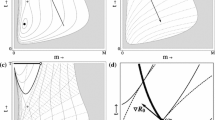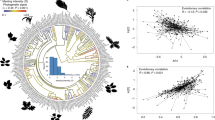Summary
We extend the classical Smith-Fretwell model for the optimal size of an offspring to the case of allocation of two or more fitness enhancing resources. Unlike the results of the single-resource model, the new model predicts that the optimal allocations will depend on the resource pool sizes. We apply this new model to the problem of carbon and nitrogen allocation to seeds and conclude (1) that the optimal seed size (carbon allocation) should be positively correlated with the ratio of the size of the carbon and nitrogen pools available for investment to offspring (C/N ratio) and (2) that there should be a negative correlation between seed size and absolute seed nitrogen content. These results may account for some of the within- and between-plant variation in resource allocation to seeds.
Similar content being viewed by others
References
Ayers, G. S., Wert, V. F. and Ries, S. K. (1976) The relationship of protein fractions and individual protein to seedling vigor in wheat.Canad. J. Plant Sci. 50, 53–8.
Berry, J. A. and Raison, J. K. (1981) Responses of macrophytes to temperature. InPhysiological Plant Ecology Vol. I (O. L. Lange, P. S. Nobel, C. B. Osmond and H. Ziegler, eds.) pp. 278–338. Springer Verlag, New York.
Bewley, D. J. and Black, M. (1985)Seeds: Physiology of Development and Germination. Plenum Press, New York.
Bradford, K. J. and Hsiao, T. C. (1982) Physiological response to moderate water stress. InPhysiological Plant Ecology Vol. II (O. L. Lange, P. S. Nobel and H. Ziegler, eds.) pp. 264–324. Springer Verlag, New York.
Bulisani, E. A. and Warner, R. L. (1980) Seed protein and nitrogen effects upon seedling vigor in wheat.Agron. J. 72, 657–62.
Cavers, P. B. and Steel, M. G. (1984) Patterns of changes in seed weights over time on individual plants.Amer. Natur. 124, 324–35.
Charnov, E. L. and Bull, J. J. (1986) Sex allocation, pollinator attraction and fruit dispersal in cosexual plants.J. Theor. Biol. 118, 321–5.
Charnov, E. L., Maynard Smith, J. and Bull, J. J. (1976) Why be an hermaphrodite?Nature 264, 125–6.
Chiariello, N. and Roughgarden, J. (1984) Storage allocation in seasonal races of an annual plant: optimal versus actual allocation.Ecology 65, 1290–1301.
Ching, T. M. and Rynd, L. (1978) Developmental differences in embryos in high and low protein seeds during germination.Plant Physiol. 62, 866–70.
Cohen, D. (1971) Maximizing final yield when growth is limited by time or limiting resources.J. Theor. Biol. 33, 299–307.
Ene, B. N. and Bean, E. W. (1975) Variation in seed quality between certified seed lots of perennial rye grass and their relationship to nitrogen supply and moisture status during seed development.J. Br. Grassl. Soc. 30, 195–9.
Evans, L. E. and Bhatt, G. M. (1977) Influence of seed size, protein content and cultivar on early seedling vigor in wheat.Canad. J. Plant Sci. 57, 929–35.
Field, C. (1983) Allocating leaf nitrogen for the maximization of carbon gain: leaf age as a control on the allocation program.Oecologia 56, 341–7.
Field, C. and Mooney, H. A. (1983) Leaf age and season effects on light, water, and nitrogen use efficiency in a California shrub.Oecologia 56, 348–55.
Geber, M. A. and Charnov, E. L. (1986) Sex allocation in hermaphrodites with partial overlap in male/female resource inputs.J. Theor. Biol. 118, 33–43.
Goldman, D. A. and Willson, M. F. (1986) Sex allocation in functionally hermaphroditic plants: a review and critique.Bot. Rev. 52, 157–94.
Harper, J. L. (1981) The concept of population in modular organisms. InTheoretical Ecology: Principles and Applications (R. M. May, ed.) pp. 57–77. Blackwell, Oxford.
Harper, J. L., Lovell, P. H. and Moore, K. G. (1970) The shapes and sizes of seeds.Ann. Rev. Ecol. Syst. 1, 327–56.
King, D. and Roughgarden, J. (1982) Multiple switches between vegetative and reproductive growth in annual plants.Theor. Pop. Biol. 21, 194–204.
King, D. and Roughgarden, J. (1983) Energy allocation patterns of the California grassland annualsPlantago erecta andClarkia rubicunda. Ecology64, 16–24.
Lowe, L. B. and Ries, S. K. (1972) Effects of environment on the relation between seed protein and seedling vigor in wheat.Canad. J. Plant Sci. 52, 157–64.
Lowe, L. B. and Ries, S. K. (1973) Endosperm protein of wheat seed as a determinant of seedling growth.Plant Physiol. 51, 57–60.
Lowe, L. B., Ayers, G. S. and Ries, S. K. (1972) Relationship of seed protein and amino acid composition to seedling vigor and yield of wheat.Agron. J. 64, 608–11.
Mayer, A. M. and Poljakoff-Mayber, A. (1982)The Germination of Seeds. Pergamon Press Ltd., Oxford.
McGinley, M. A., Temme, D. H. and Geber, M. A. Parental investment to offspring in variable environments: theoretical and empirical considerations.Amer. Natur. 130, 370–98.
Parrish, J. A. and Bazzaz, F. A. (1985) Nutrient content ofAbutilon theophrasti seeds and the competitive ability of resulting plants.Oecologia 65, 247–51.
Pate, J. S. (1984) The carbon and nitrogen nutrition of fruit and grain seed-case studies of selected grain legumes. InSeed Physiology Vol. 1 (D. R. Murray, ed.) pp. 41–82. Academic Press, London.
Pate, J. S. and Layzell, D. B. (1981) Carbon and nitrogen partitioning in the whole plant — a thesis based on empirical modeling. InNitrogen and Carbon Metabolism (J. D. Bewley, ed.) pp. 94–134. D. W. Junk, London.
Ries, S. K. and Everson, E. H. (1973) Protein content and seed size: relationship with seedling vigor of wheat cultivars.Agron. J. 65, 884–6.
Ries, S. K., Moreno, O., Meggett, W. F., Schweizer, C. J. and Ashkar, S. A. (1970) Wheat seed protein: chemical influence on and relationship to subsequent growth and yield in Michigan and Mexico.Agron. J. 62, 746–8.
Schweizer, C. J. and Ries, S. K. (1969) Protein content of seed: increase improves growth and yield.Science 165, 73–5.
Smith, C. C. and Fretwell, S. D. (1974) The optimal balance between size and number of offspring.Amer. Natur. 108, 499–506.
Snell, T. W. (1976) Effects of density on seed size and biochemical composition.Amer. Midl. Natur. 95, 499–507.
Watson, M. A. and Casper, B. B. (1984) Morphogenetic constraints on patterns of carbon distribution in plants.Ann. Rev. Ecol. Syst. 15, 233–58.
White, J. (1984) Plant metamerism. InPerspectives on Plant Population Ecology (R. Dirzo and J. Sarukhan, eds.) pp. 15–47. Sinauer Associates, Inc., Sunderland, Massachusetts.
Author information
Authors and Affiliations
Rights and permissions
About this article
Cite this article
McGinley, M.A., Charnov, E.L. Multiple resources and the optimal balance between size and number of offspring. Evol Ecol 2, 77–84 (1988). https://doi.org/10.1007/BF02071590
Issue Date:
DOI: https://doi.org/10.1007/BF02071590




